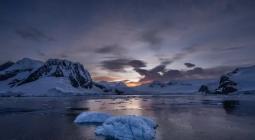‘The extreme events scare me the most’: climatologist warns of Italy’s vulnerability to climate crisis

Luca Mercalli describes Italy as ‘one of the most fragile places in the world’ after recent storms, wildfires and glacier collapse.
The collapse of a glacier in the Dolomites and a landslide on the island of Ischia. Devastating floods, wildfires and record-breaking heatwaves. The worst drought of the Po, Italy’s longest river, in 200 years. Luca Mercalli, an Italian climatologist, has seen his fair share of extreme weather events in Italy within the past two years. But nothing prepared him for the scene in Mortegliano, a small town in Friuli-Venezia Giulia, the northern region bordering Slovenia.
Mercalli, the president of the Italian Meteorological Society, and noted for having stormed off TV debates after becoming frustrated by climate crisis deniers, was in the area by chance days after powerful storms wreaked havoc in northern Italy in late July, killing five people.
As winds exceeding 63mph (100km/h) ripped through Milan, two hailstone records were smashed within five days of each other. The first was on 19 July, when a hailstone measuring 16cm (6.3in) in diameter fell in Carmignano di Brenta, a town in Veneto, beating the previous European record of 15cm set in Romania in 2016.

Then on 24 July, a 19cm (7.5in) hailstone was found in Azzano Decimo in Friuli-Venezia Giulia. In Mortegliano, a town of roughly 5,000 inhabitants, at least half a kilo of hail with estimated stone diameters of 10-15cm fell that same night. The storm lasted less than 10 minutes – but enough time to devastate almost the entire town as the chunks of ice crashed into roofs and cars, and breaking the arm of one resident. The total cost of the damage is estimated at €80m.
“It was as if the town had been bombed or hit by an earthquake – in all my experience as a climatologist, this was something that was completely new to me,” said Mercalli.
Italy is renowned for its varied landscapes, with its boot-shaped peninsula stretching from the peaks of the north and along 8,000km (about 5,000 miles) of coastline towards the islands of the south. But the country has also become known, at least by scientists, as Europe’s climate risk hotspot owing to a range of vulnerabilities including its geographical location, diverse topography and densely inhabited Mediterranean coastal areas.
“There are three elements that make Italy one of the most fragile places in the world,” said Mercalli. “One is that the Mediterranean is smaller in size compared with other oceans and is warming up more quickly. The second is that we are located in between the tropical climate of Africa and temperate climate of northern Europe – the heat in Sicily is now more like Africa, while northern Italy is like Sicily was 50 years ago. The third is the crowded Mediterranean – any extreme event risks a heavy impact in inhabited areas.”
As more violent storms were forecast to engulf northern Italy on Friday and over the weekend, the president, Sergio Mattarella, joined counterparts from Spain, Greece, Croatia and Slovenia in demanding urgent action from international leaders to tackle the climate crisis. “There is no more time to waste, no more time to compromise for political or economic reasons,” they wrote.

Mercalli is monitoring the changing climate and its effects from Borgata Vazon, a hamlet which lies 1,650m high in the Susa Valley area of the Italian Alps, to where he moved in 2017, partly motivated by cooler temperatures as global warming accelerated. However, even at this height, the heat is beginning to catch up with him: the night-time temperature on Wednesday was 15C – five degrees warmer than the norm for early August.
Mercalli has studied glaciers since 1985, noting that the speed of their retreat began to hasten towards the end of that decade. Each year brings less snow, and even if there are spells when it falls in abundance, the snow melts away more quickly.
He has seen changes in vegetation across the Alps: oak trees dating back 200 years in the Cuneo area were killed off by the heat and drought in 2022 – Europe’s hottest year on record – while plants and insects that were previously strangers to the mountains are appearing.
“I describe the mountains as the open-sky laboratory for climatology,” said Mercalli. “You see the change in the glaciers, the trees, insects, farming … everything.”

Extreme weather events in Italy in 2022, including the collapse of the Marmolada glacier, flooding in the Marche region and the Ischia landslide, killed 36 people. In May, 14 people died in flooding in Emilia-Romagna, while four were killed in recent wildfires in Calabria and Sicily. During the summer of 2022, people died at the highest rates from heat in Italy, more than in Greece, Spain and Portugal.
A 2021 report by Ispra, the Italian government’s environment agency, found that 7,423 municipalities (93.4% of the total) were at risk of landslides, floods and coastal erosion. Another significant report by Ispra last year said that Italy had lost an average of 77 sq km (about 30 sq miles) a year of natural and semi-natural soil between 2006 and 2021, mainly due to urban expansion, exacerbating the damage caused by natural events.
‘I lost everything’: Italians count cost of deadly flood in Marche
But despite these stark facts, there has been scant action by successive governments while the strategy of the current rightwing administration, led by Giorgia Meloni, is vague. Before taking power last October, Meloni had railed against the “ultra-ecologists of the left” and in July said Italy cannot be expected to “dismantle” its economy and businesses in order to implement the “ecological transition”. Her deputy, Matteo Salvini, last week joked on TV about the heatwaves and melting glaciers, saying “summers are hot, winters are cold”. The environment minister, Gilberto Pichetto Fratin, an accountant, said that while the change in the climatic system was there for all to see, he was unsure if it was due to cyclical factors or caused by human beings.
Mercalli is among the few climatologists putting their heads above the parapet in a country whose media gives ample space to climate crisis deniers. As a result, Mercalli and his colleagues have been targeted by extremist groups as “the enemies of humanity”. But, he warns, if Italy continues to ignore the issue, there will be a high price to pay.
“The extreme events scare me the most,” he said. “The hailstorm in Mortegliano and cost of the damage was enough to bring it home even more. They cause chaos in society and such events are starting to exceed our tolerance threshold – there are just too many of them now.”



